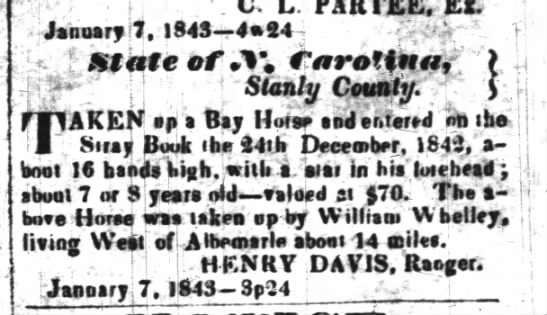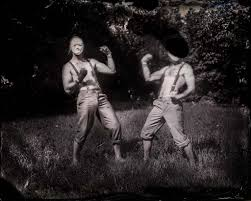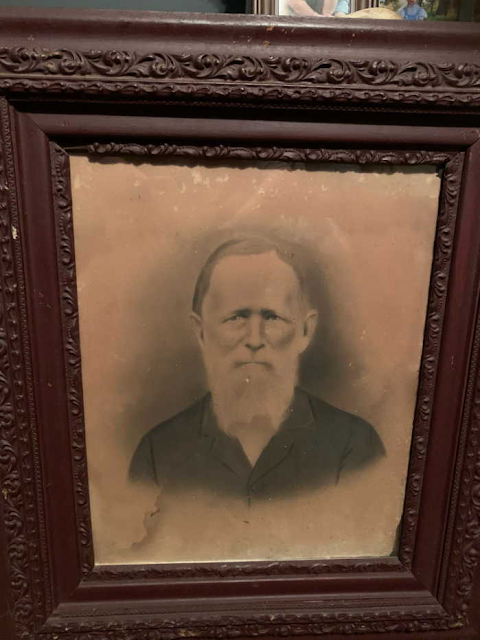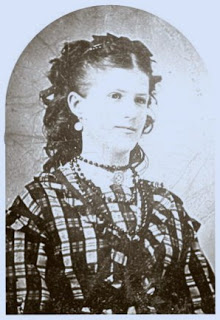In my earlier post, The Schoolhouse, I explored a nontypical, brief deed wherein my Third Great Grandfather, Henry Davis, deed a half-acre's lot to a School that obviously already sat upon it. The deed, shown below, was witnesses by two men I knew, James Palmer, my Fourth Great Grandfather, and Henry's father-in-law, and Bailey Smith, his brother-in-law. They had married Palmer sisters. It was also witnessed by two men I did not know, James Sanders and Albert Smith. I wondered if James Sanders could have been related to Bailey Sanders, and if the first name of "Bailey" had somehow descended through a Bailey family line to both Baily's, Smith and Sanders. I also wonder about who was Albert Smith? Was he a relative of Bailey Smith?
I've done a bit of ferreting around the Smith family within the past year, as I have a link to one branch, and discovered that Bailey Smith, was descended from a William Smith who passed away in the 1840's. During my rootling around, I did not come across an Albert.
Brief lives who left no heirs and few traces are often viewed as inconsequential by genealogy hounds and are disregarded. Left to collect dust, those without descendants fade away into oblivion, forgotten and dishonored. Yet I'm as intrigued by the mysterious as the perspicuous. Enter Albert Smith. Who was he?
Although his name had not caught my attention until the schoolhouse deed, I soon came across it again, as I was perusing the 1841 land entries in Stanly County, the year of its formation. Albert Smith is mentioned twice in these, and that fact is very telling. It again brings him in the sphere connection to the same people in the deed.
Entry 80, dated December 20, 1841, has Albert Smith with 100 acres of land on the waters of Mountain Creek, adjoining John C. Smiths line. So, here he is in connection with another Smith. The next entry, number 81, on the same date, is John C. Smith's entry for 100 acres on Mountain Creek, adjoining Albert Smith's entry. Nothing to see here, however, it's the entries preceding Alberts, also on the same date, that pique my interest.
77 12-20-1841 James Palmer enters 100 acres on the waters of Mountain Creek adj. Joseph Picker.
78 12-20-1841 Elisha Smith enters 100 acres on the waters of Mountain Creek adj James Palmers.
79 12-20-1841 Williamson Smith enters 100 acres on the waters of Mountain Creek adj Elisha Smith.
A hive of Smith's with connection to James Palmer, perhaps? Then, in March, I had discovered the following:
391 3-25-1841 John Davis 100 acres on S. W. side of Mountain Creek adjoining B.F. Davis's 100-acre entry. These were the two oldest sons of Henry Davis.
393 3-28-1841 John C Smith 100 acres on the waters of Mountain Creek adj. his own lines.
394 3-28-1841 Albert Smith entered 100 acres on the waters of Mountain Creek adjoining John C. Smith's entry.
There were at a minimum, three distinct families of Smiths in the area in those days, and possibly as many as five or six. I will not try to separate them out or tie them together, just the one group with ties to my Davis and Palmer lines.
On March 25th, Bailey Smith, Henry's brother-in-law, also entered 100 acres on the S.W. side of Mountain Creek adjoining Joseph Pickler's line and on the same day, Bailey's son Edward P. Smith entered 100 acres joining his father's line. These were entries 388 and 389. Entry 390, just before the John Davis entry seen above, was the one for his brother, Benjamin Franklin Davis. On the same date as John, March 25th, he entered:
"100 acres on the S. W. side of Mountain Creek adjoining Bailey Smiths' and Edward P Smith's line."
One might think that in a census record, either the one before or after, you'd find all these folks together in a little community along Mountain Creek and there would be Albert, but no. James Palmer is not listed near any Smiths at all, and neither is Bailey Smith.
1850 is a different story. Bailey is listed next to his mother, Elizabeth Smith, his brother, James Smith and near a John Smith and his wife, Lurena. No Albert anywhere.
The thing about the land entries, they are void of any indicators of age, unlike census records. For instance, in 1841, in the above entries, B. F. Davis, born in 1829, was about 12, and his younger brother John, about 10. Same with Edward Pinkney Smith, son of Bailey Smith, born in 1932, he was only 9. These men, (Henry Davis and Bailey Smith), had entries applied to for their young sons. So, seeing Albert Smiths name there does not mean he was an adult.
Albert Smith does appear in other documents, however.
The above shows John Smith and Albert Smith, side by side, making purchases from an estate. There is a signature of James Smith, Executor of the Estate.The above is the Estate file this document came from, that of William Smith who passed away in 1845. James Smith was his son, and so was Bailey Smith. I posted on James Smith here: The Mysterious Disappearance of James Smith
This is another excerpt from the William Smith, Referring to A.C. and Robert Smith, Robert being a proven son of William Smith and A.C being a son of Robert.
Yet another excerpt mentions James, William and Bailey Smith.
This next list in a row shows Bailey, Robert and Archibald C. Smith, along with Arthur Freeman Atkins and Henry Davis. A. F. Atkins is related to the mother of Mary Palmer Smith and Martha Palmer Davis, who was an Atkins, and perhaps even related to Henry Davis through his grandmother, Charlotte Freeman.
Above is another document containing the name of Albert Smith. It's the 1843, 100-acre Grant to Edward Pinkney Smith, son of Bailey and Mary Palmer Smith. The property was located on the Camp Branch of Mountain Creek. It joined the lands of William Smith, his grandfather, and Joseph Pickler, a name often seen in the deeds of this extended family. The witnesses were Joseph Pickler and Albert Smith.
The row of consecutive land entries for Bailey Smith adjoining Joseph Pickler and William Smith, Edward Pinkney Smith adjoining the same, James Palmer adjoining Joseph Pickler, Elisha Smith adjoining James Palmer, Williamson Smith adjoining Elisha Smith, and Albert Smith adjoining John C Smith, all on Mountain Creek.
Those were followed by John C Smith's entry adjoining Albert Smith's. Albert seems to be mostly connected to John C. Smith and this group of Smiths, as a whole, could very well be one family.
| Name | George A Smith |
|---|---|
| Gender | Male |
| Race | White |
| Residence Age | 30 |
| Birth Date | abt 1820 |
| Birthplace | North Carolina |
| Residence Date | 1850 |
| Home in 1850 | Albemarle, Stanly, North Carolina, USA |
| Occupation | Laborer |
| Industry | Industry Not Reported |
| Line Number | 14 |
| Dwelling Number | 934 |
| Family Number | 939 |
| Inferred Spouse | Mary Smith |
| Inferred Child | Louisa Smith |
| Name | Age |
|---|---|
| George A Smith | 30 |
| Mary Smith | 22 |
| Louisa Smith | 2 |
| Name | George A Smith |
|---|---|
| Gender | Male |
| Race | White |
| Birthplace | North Carolina |
| Home in 1860 | Salisbury, Rowan, North Carolina |
| Post Office | Gold Hill |
| Dwelling Number | 496 |
| Family Number | 480 |
| Occupation | Day Labourer |
| Personal Estate Value | 50 |
| Inferred Child | Mary A Smith |
| Name | Age |
|---|---|
| George A Smith | |
| Mary A Smith | 32 |
| Louisa C Smith | 11 |
| Sarah L Smith | 9 |
| Carrell E Smith | 8 |
| John T Smith | 10/12 |
As shown above, Albert fought at such notable places as Cold Harbor, Malvern Hill, Chancellorsville, and Gettysburg, where he was wounded and captured.
| Name | George Albert Smith |
|---|---|
| Enlistment Age | 40 |
| Birth Date | abt 1822 |
| Enlistment Date | 22 Mar 1862 |
| Enlistment Place | Cabarrus County, North Carolina |
| Enlistment Rank | Private |
| Muster Date | 22 Mar 1862 |
| Muster Place | North Carolina |
| Muster Company | A |
| Muster Regiment | 20th Infantry |
| Muster Regiment Type | Infantry |
| Muster Information | Enlisted |
| Imprisonment Date | 3 Jul 1863 |
| Imprisonment Place | Gettysburg, Pennsylvania |
| Casualty Date | 27 Jun 1862 |
| Casualty Place | Gaines' Mill, Virginia |
| Type of Casualty | Wounded |
| Muster Out Date | 12 Aug 1863 |
| Muster Out Place | David's Island, New York |
| Muster Out Information | died disease POW |
| Side of War | Confederacy |
| Survived War? | No |
| Residence Place | Cabarrus County, North Carolina |
| Notes | 1862-09-01 Returned, estimated day; 1863-06-30 Returned, Estimated day; 1863-07-17 Transferred, (David's Island, NY Harbor) |
| Additional Notes 2 | Casualty 2 Date: 17 Sep 1862; Casualty 2 Place: Sharpsburg, Maryland; Casualty 2 Type of Casualty: Wounded; Casualty 2 Information: Estimated day; Casualty 3 Date: 03 Jul 1863; Casualty 3 Place: Gettysburg, Pennsylvania; Casualty 3 Type of Casualty: Hospitalized; Casualty 4 Date: 03 Jul 1863; Casualty 4 Place: Gettysburg, Pennsylvania; Casualty 4 Type of Casualty: Wounded; Casualty 4 Information: Wounded in the foot |
| Title | North Carolina Troops 1861-65, A Roster |
| Name | Geo A Smith |
|---|---|
| Death Date | 13 Aug 1863 |
| Interment Date | 13 Aug 1863 |
| Interment Place | New York, USA |
| Cemetery Address | 625 Jamaica Avenue Brooklyn, NY 11208 |
| Cemetery | Cypress Hills National Cemetery |
| Plot | Section 1 Site 776 |
| Notes | Us Army |
| Name | Mary Smith |
|---|---|
| Age in 1870 | 44 |
| Birth Date | abt 1826 |
| Birthplace | North Carolina |
| Dwelling Number | 84 |
| Home in 1870 | Salisbury, Rowan, North Carolina |
| Race | White |
| Gender | Female |
| Post Office | Salisbury |
| Occupation | No Occupation |
| Name | Age |
|---|---|
| John H Verble | 50 |
| Nancy Verble | 60 |
| Mary Smith | 44 |
| Richard Julian | 11 |
| Hattie Klutts | 8 |
| Name | Edward Smith |
|---|---|
| Age in 1870 | 18 |
| Birth Date | abt 1852 |
| Birthplace | North Carolina |
| Dwelling Number | 266 |
| Home in 1870 | Atwell, Rowan, North Carolina |
| Race | White |
| Gender | Male |
| Post Office | Salisbury |
| Occupation | Farm Laborer |
| Name | Age |
|---|---|
| John O King | 42 |
| Martha King | 24 |
| Joseph W King | 13 |
| Rosy King | 9 |
| Mary A King | 8 |
| Nannie K King | 6 |
| John O King | 4 |
| Mattie B King | |
| Sarah Mills | 21 |
| Jane Barnhart | 21 |
| Edward Smith | 18 |
| Name | Sarah Mitcher |
|---|---|
| Age in 1870 | 18 |
| Birth Date | abt 1852 |
| Birthplace | North Carolina |
| Dwelling Number | 225 |
| Home in 1870 | Township 1, Cabarrus, North Carolina |
| Race | White |
| Gender | Female |
| Post Office | Concord |
| Occupation | Keeping House |
| Inferred Spouse | Victor Mitcher |
| Name | Age |
|---|---|
| Victor Mitcher | 31 |
| Sarah Mitcher | 18 |
| Florence Mitcher | 3 |
| Name | Louisa Smith |
|---|---|
| Age in 1870 | 25 |
| Birth Date | abt 1845 |
| Birthplace | North Carolina |
| Dwelling Number | 49 |
| Home in 1870 | Ridenhour, Stanly, North Carolina |
| Race | White |
| Gender | Female |
| Post Office | Albemarle |
| Occupation | At Home |
| Cannot Read | Yes |
| Cannot Write | Yes |
| Inferred Mother | Jane Smith |
| Name | Age |
|---|---|
| Jane Smith | 41 |
| Louisa Smith | 25 |
| Lucy J Welson | 7 |
| William Welson | 4 |
| Nancy Lowder | 35 |
Son, Carroll Edward Smith, 21, married Lorena Catherine Redwine, 17, on February 23, 1874. The bride was the daughter of J. D. and Phoebe G. Redwine, both living, while the groom reported that he was the son of George A. Smith, deceased, and Mary A. Smith, living. Both lived in Township 7 of Cabarrus County, and the wedding took place at the home of the bride's parents. Performed by Rev. Thomas M. Joiner, a Methodist Episcopal Minister, witnesses again were C. J. Russell, William G. Melchor and S. C. Fisher. (husband of sister Louisa).
Louisa C. Smith was married on March 2, 1871, to Calvin Solomon Fisher, son of Solomon Fisher and Christena Foutz Fisher. The groom was 21 and the bride was 22. His name is seen as both Solomon Calvin and Calvin Solomon. The wedding was performed at the bride's mother's house by Rev. John C. Denny, in Cabarrus County.
Their Lives
Mary Addams Clayton Smith Barringer would settle in the Reed Masenheimers part of Cabarrus County. This, again, was near Gold Hill and not far from the northernmost part of Stanly County.
| Name | Mary A. Barringer |
|---|---|
| Age | 51 |
| Birth Date | Abt 1829 |
| Birthplace | North Carolina |
| Home in 1880 | Reed Misenheimers, Cabarrus, North Carolina, USA |
| Dwelling Number | 287 |
| Race | White |
| Gender | Female |
| Relation to Head of House | Wife |
| Marital Status | Married |
| Spouse's Name | George W. Barringer |
| Father's Birthplace | North Carolina |
| Mother's Birthplace | North Carolina |
| Occupation | Housekeeper |
| Neighbors | View others on page |
| Name | Age |
|---|---|
| George W. Barringer | 63 |
| Mary A. Barringer | 51 |
| George A. Barringer | 19 |
George W. Barringer was a widower with 6 grown children. They are seen above in the 1880 census, with his youngest son, George Addison Barringer. George Wilson Barringer would pass away on Halloween in 1894, leaving Mary, again, a widow.
She is found in 1900, at 71, living in King's Creek, Cabarrus County, with her oldest daughter, Louisa and her family. In 1910, she's back in Township 7, appearing to live in her own home, but she's sandwiched between 'Edward C. Smith', her son Carroll Edward, and Adam Edward Smith, his oldest son, and Burton A. Culp, who was married to Carroll's oldest daughter, Esther Lucy Smith. Carroll was a farmer, but Burton was a Gold Mining Engineer and Adam was a miner.
Mary Addam Clayton Smith Barringer passed away on November 27, 1914, at the age of 85. She was buried at Oakwood Cemetery in Concord, Cabarrus County with her second husband, George Wilson Barringer. The informant was her son-in-law, Solomon Fisher, and he got a few things wrong. He had her maiden name as Moore, possibly because her brother married a Moore, and they knew each other somewhat. The reason for her death was heart regurgitation due to Old Age. Mary had been the mother of 4 known children, Louisa C., Sarah L., Carroll Edward and John T. Smith.
Louisa C. Smith Fisher was born October 20, 1848. She married Solomon Calvin Fisher and became the mother of 5 children:
1872-1943 Mary Ellen Fisher Ritchie Bost
1876-1953 Minnie Corabell Fisher Penninger
1878-1967 Rose Christine Fisher Mabry
1883-1966 Jason Holmes Fisher
1887-1943 Charles Albert Fisher
Louisa raised her children in Cabarrus County.
She passed away on October 10, 1934, and is buried in Oakwood Cemetery in Concord, like her mother.
Sarah L. Smith Melchor was born on November 4, 1850. She married Victor Theopolis Melchor and became the mother of 5 children:
1867-1939 Florence E. Melchor Misenheimer
1873-1948 James Oscar Melchor
1877-1964 Walter Deberry Melchor
1879-1899 Charles H. Melchor
1886-1963 Hattie Marybelle Melchor Voncannon
Sarah raised her family in the Reed Misenheimer District of Cabarrus County.
She passed away on February 3, 1929, and was buried at Saint Stephens Lutheran Church in Gold Hill, Rowan County. Her Death Certificate gave her father's name as Albert Smith, born in Stanly County and her mother as Molly Clayton, born in Rowan County. She died of Influenza and other complications due to Nephritis.
Carroll Edward Smith was born February 24, 1853, in Gold Hill, Rowan County, North Carolina. He married Lorena Catherine Redwine and became the father of 6 children.
1874-1877 John M. Smith was one month shy of 4 years old when he died. He is buried at Matton's
Grove UMC Church in Richfield, Stanly County, NC.
1876-1876 Minnie Smith was 3 weeks old when she died. She is also buried at Matton's Grove in Richfield, NC.
1878-1942 Adam Edward Smith became the oldest sibling to make it to adulthood. He married Mary Jane Fisher.
1885-1968 Esther Luticia Smith Culp, married Burton L. Culp.
1889-1965 Rufus Alexander Coy Smith, married Gertrude Harmon and Flora Belva Furr.
1894-1972 Myrtle E. Smith Payseur, married Darius F. Payseur
Carroll Smith raised his family in Cabarrus County Township 7, nearly right on the Stanly County line, in the Matton's Grove Church Community. He died on May 11, 1913, at the age of 60, and is buried at Matton's Grove.
Albert Smith appears to me to be a member of the William Smith family, who died in 1845 in Stanly County. Exactly how, I have not discovered, but this is the branch of Smiths he was in close association with, including Bailey F. Smith and James Smith, whom I have blogged about. He may have been a nephew of those. Again, this is simply a theory based on circumstantial evidence. He married Mary Addams Clayton, daughter of Joseph Clayton and Margeret Houston Clayton and had at least 4 children, three known to have made it to adulthood. He was one of the casualties of the Civil War. George Albert Smith has many living descendants to this day.





















































